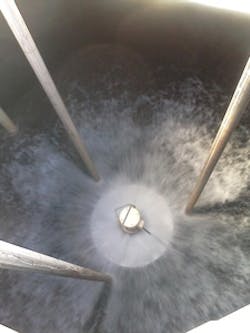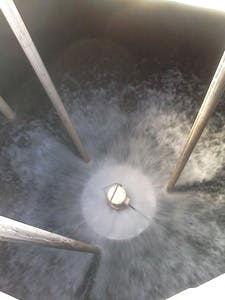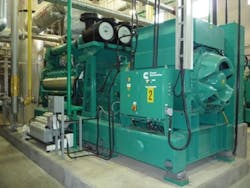Study Evaluates Combined Heat, Power Technologies for WWTPs
One proven means for reducing electric power consumption at wastewater treatment facilities is to use anaerobic digestion to produce digester gas and then use the digester gas as a fuel for the combined production and beneficial use of heat and electrical power.
For many larger facilities, use of digester-gas-fueled CHP has the potential to offset energy consumption by 30 to 100 percent, according to Jason Wiser, project manager and co-author of a recent study, “Evaluation of Combined Heat and Power Technologies for Wastewater Facilities.” Wiser and fellow Brown & Caldwell engineers Jim Schettler and John Willis wrote the report for the Columbus Water Works of Georgia with funding provided by a grant from the US Environmental Protection Agency.
The interim report serves as a planning-level tool for wastewater professionals and provides an examination of commonly used and emerging CHP technologies for converting anaerobic digester gas to electrical power and process heat. The report includes detailed process descriptions and performance and cost data. It also addresses factors such as infrastructure requirements, digester gas treatment, and operational issues.
“The overarching message of the report is that wastewater treatment facilities are consumers of electricity, but if they are configured correctly and they include anaerobic digestion, they can become producers of energy,” Wiser said.
The overall percentage of energy recovery possible is influenced by a combination of factors including the effectiveness of the digestion process, the efficiency of the CHP system, the type of treatment processes, and the efficiency of the POTW’s liquid stream treatment.
A few wastewater treatment plants in Europe have become energy self-sufficient using combined heat and power systems, including the Strass plant in Austria and the Grevesmühlen plant in Germany. A few POTWs in the USA are reportedly close to being fully energy self-sufficient and occasionally produce more power than is needed. These include the Point Loma Waste Water Treatment Plant in San Diego, CA, and the Joint Water Pollution Control Plant in Carson, CA.
In the past, because of economies of scale, CHP systems have been thought to be cost-effective only at plants with treatment capacities in excess of 10 mgd. However, a few smaller POTWs are successfully operating CHP systems and many would argue that the traditional 10-mgd threshold, in certain locations, should be revised to about 4 or 5 mgd, Wiser said.
Smaller facilities can boost their digester gas output, making CHP more economically feasible, by accepting alternative feedstocks such as fats, oils, and grease (FOG), food waste, and process waste from beverage industries, just to name a few alternatives. The addition of FOG and other highly digestible waste streams to the anaerobic digestion process can dramatically enhance digester gas production.
“The more alternate feedstocks you accept, the more digestible material you have, and the more digester gas you can produce. Which means you’re going to produce more energy,” Wiser said.
Because FOG and similar materials are so readily degradable, they can often be added directly to the digesters, without having to increase treatment capacity.
Combined heat and power systems typically are designed to generate electricity and produce heat as a byproduct. Anaerobic digestion is very compatible because it requires a continuous year round heat source to warm the digesters and produces digester gas, a “free” source of fuel for the CHP system.
Most anaerobic digesters are operated at mesophilic temperatures between 95 and 100 degrees F (35 to 38 degrees C). Thermophilic digesters operate at temperatures between 124 and 138 degrees F (51 to 59 degrees C). Properly operated CHP systems can supply all of the heat required by the anaerobic digestion process and at the same time can offset a significant portion of a POTW’s electric power demand.
“Internal combustion engines and combustion gas turbines are without question the most mature combined heat and power technologies suitable for digester gas. They have been in service at wastewater treatment plants for decades,” Wiser said. “Newer technologies such as micro turbines and fuel cells are starting to get a toe hold in the wastewater market but are not as mature.”
Fuel cells offer the advantage of efficiency and clean emissions, but are hampered by the current high cost of ownership on a dollars per kilowatt basis.
“A lot of times the only way a fuel cell project makes sense is if grant money is involved,” Wiser said. “The beauty of fuel cells is their extremely clean emissions, far cleaner than the other technologies. In fact there are certain areas of California that will not allow combustion devices to be permitted, but they will allow fuel cells, because of air quality issues.”
On an electrical basis fuel cells are the most efficient of the available technologies and regularly achieve over 40 percent efficiency. However, in terms of recovering heat they are far less efficient than the other technologies.
“When you are considering electrical efficiency and overall heat recovery then typically the internal combustion engine and the combustion gas turbine are the most efficient. But, it’s hard to make a blanket statement and it’s something that must be evaluated on a case by case basis,” Wiser said.
Internal combustion engines have a come a long way in recent years, he noted. New lean-burn engines can have an electrical efficiency of 40 percent or more. Cogeneration engines installed from the 1950s through the early 1980s were the rich-burn type that operated with a low air-to-fuel ratio. In comparison, lean-burn is the common designation for engines with higher air-to-fuel ratios found in advanced generation systems.
“Internal combustion engines have always done very well in terms of their ability to recover heat,” Wiser said. “Like your car engine develops a lot of heat, much of that heat is recoverable and can be used in the digestion process.”
Heat is captured from the exhaust systems and the jacket water system used to cool the engine. In contrast, heat recovery from combustion gas turbines and microturbines is solely from the exhaust.
Regardless of type of technology used, the digester gas must first be treated to remove hydrogen sulfide, moisture and siloxanes. Exhaust emissions are also a concern, with standards varying from region to region.
Case Study
The combined heat and power study was completed as part of a larger anaerobic digestion improvement project to develop a CHP system for the South Columbus Water Resource Facility (SCWRF) in Columbus, GA. The CHP facility, constructed at a cost of approximately $15 million, began operation earlier this year and is currently in its shake-down phase.
The SCWRF CHP system features two 1,750 kW Cummins 1750GQNB engines. These advanced generation, high-efficiency, lean-burn engines were selected following a detailed evaluation of several CHP technologies, including conventional lean-burn engines, gas turbines, microturbines, and fuel cells.
Lean-burn engines were selected based on their lower capital cost, high electrical efficiency, and the high-grade heat produced by the engines for heating the digestion process to thermophilic temperatures. Also, the presence of several engine manufacturers in the marketplace enhanced Columbus Water Works’ comfort level with this new technology refinement.
The engines are fueled by digester gas produced by Columbus’ unique biosolids treatment system, known as the Columbus Biosolids Flow-Through Thermophilic Treatment (CBFT3) system.
The CBFT3 process is essentially a new high-rate form of temperature phased anaerobic digestion (TPAD), consisting of mesophilic and thermophilic digestion phases. The CBFT3 maximizes the production of anaerobic digester gas for subsequent conversion to renewable energy and also produces Class A biosolids.
The Columbus facility is a conventional activated sludge plant and had historically operated an anaerobic digestion system. For this project, one of its three existing digesters was converted to thermophilic operation at 55 degrees C with the remaining two digesters continuing to operate at 35 degrees C. The thermophilic digester is the first step in the CBFT3 process followed by two plug-flow reactors (PFRs) that both operate at 55 degrees C. The two reactors provide 30-40 minutes of batch contact time for pathogen destruction in a flow-through configuration.
The two mesophilic digesters follow the PFRs to complete the high-rate TPAD process. The mesophilic digestion phase is used for additional vector attraction reduction and to minimize odors in the treated biosolids. The mesophilic digestion process achieves a volatile solids reduction of about 58 percent, while volatile solids reduction from the thermophilic digestion process is about 65 – 68 percent.
To further enhance digester gas production, Columbus also began accepting FOG from the surrounding community. The FOG receiving and processing system improves overall digester gas production by about 10 percent while increasing sludge volume reduction by an estimated 10 percent.
It is estimated that the CBFT3, CHP and FOG systems will result in a net carbon footprint reduction of 9,600 metric tons per year of CO2 equivalent, primarily as a result of purchased electricity and natural gas offsets. Approximately 40 percent of the SCWRF’s electrical demand is offset by power generated by the CHP system. Based on electric energy savings at $0.075/kWh, payback for the CHP system is estimated at less than 10 years.
WW
References: Additional information on combined heat and power systems in the wastewater treatment market may be found by visiting the EPA website at www.epa.gov/chp/markets/wastewater.html. Information on the Columbus CBFT3 system and a copy of the report “Evaluation of Combined Heat and Power Technologies for Wastewater Facilities, may be found by visiting the “Reports and more” section of the Columbus Water Works website at www.cwwga.org.
More WaterWorld Current Issue Articles
More WaterWorld Archives Issue Articles



